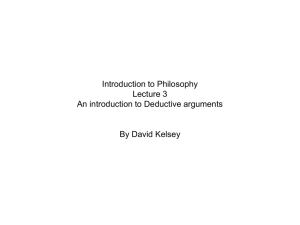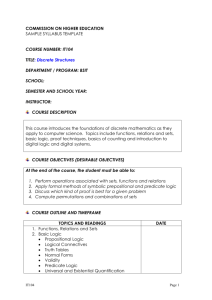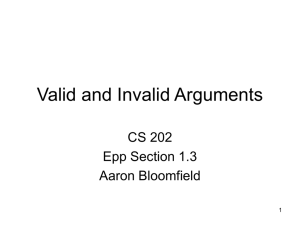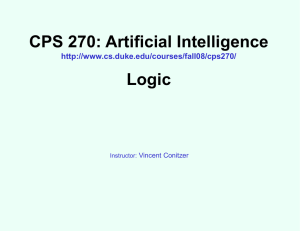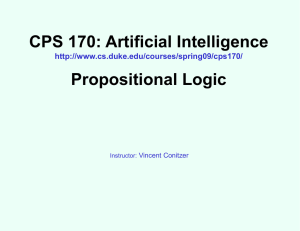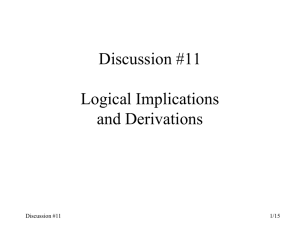P - The Aristotelian Society
advertisement
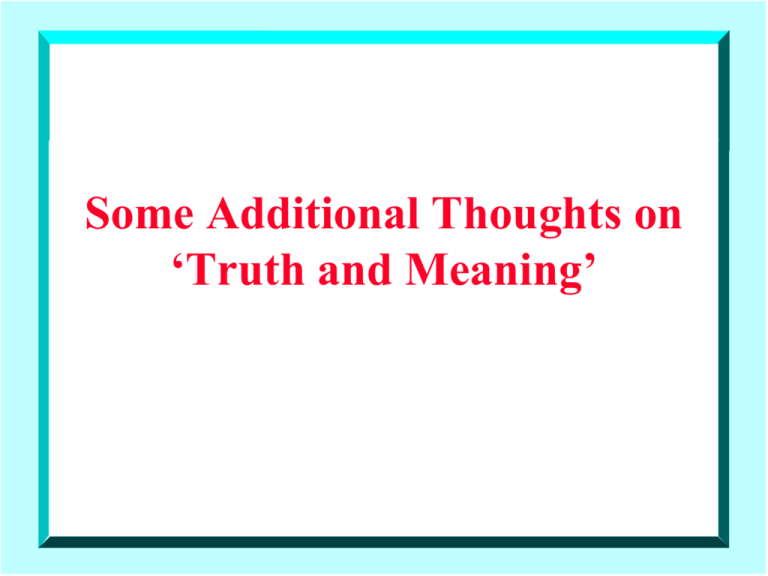
Some Additional Thoughts on ‘Truth and Meaning’ Consider ‘Caesar was murdered, but it was not necessary that Caesar was murdered’. Not only is this statement readily intelligible, it is true. (IR p. 24) It does not follow from this difference, however, that there is any equivocation—any shift in meaning—between the two occurrences of ‘was murdered’. Nor does it follow that it is illicit to symbolize our statement in the form ‘P ∧ ¬ P’. There is, then, no reason to doubt the legitimacy of the repeated variables in Ramsey’s formula ‘B is a belief that P ∧ P’. A confirmed extensionalist will not be moved by the parallel, rejecting the logical form assigned the modal formula too. Caesar was murdered ¬( is analytic) Caesar was murdered They are not objects because ‘the way things are thought to be when someone thinks that Running Rein was four years old’ is not a genuine singular term or Eigenname. (p. 27) Well, it is grammatically. What makes it nongenuine? 1 (1) 2 (2) (3) (4) (5) (6) (7) (8) (9) (10) (11) (12) (13) (14) (15) (16) (17) (18) (19) (20) 2 1 1,2 6 (1,2),6 2,6 2,6 ((1,2),6)(2,6) (1,2),(1,2,2,6) 12 12 12 1 1,12 12 (1,12),12 12,((1,12),12) (1,2),(1,2,2,6) 12,(1,12) ∀Q(δQ (Q ¬P(δP ∧ P)) RδR δR δR (R ¬P(δP∧P)) R ¬P(δP∧P) R ¬P(δP ∧ P) δR ∧ R P(δP ∧ P) ¬R ¬¬P(δP ∧ P) ∃P(δP ∧ P) δS ∧ S δS δS (S ¬P(δP ∧ P)) S ¬P(δP ∧ P) S ¬P(δP ∧ P) ¬P(δP ∧ P) ¬RδR Premiss Assumption, for reductio 2 Instantiation 1 I 3, 4 modus ponens Assumption 5, 6 ∧E and modus ponens 3, 6 ∧I 8 I 7, 9 reductio, discharging assumption 6 5, 10 ∧-E and modus tollens Assumption 12 Instantiation 13 ∧E 1 I 14, 15 modus ponens 13 ∧E 16, 17 ∧Eand modus ponens 12, 18 reductio, discharging assumption 12 11, 19 reductio, discharging assumption 2 We would also get into trouble if we applied our rules to ‘Everything a Cretan says should be rejected as untrue’. I think we just have to concede that problems would arise if the entire semantic machinery of the present paper were to be projected into the object language: the limitations on such projection mean (as in Kripke’s theory) that ‘the ghost of the Tarski hierarchy is still with us’ (Kripke 1975, p. 714). But the ghost is far less inhibiting than the hierarchy proper: the rules proposed enable us to do a great deal of semantic theorizing within our system. If the (very substantial) ghost is not to be exorcised, why not just stick with Tarskian hierarchialism? It’s pretty straightforward and one can do a lot of semantic theorising about the object language. Not about the language of the semantic theory itself it’s true[sic]- but the same is true on the above account.
